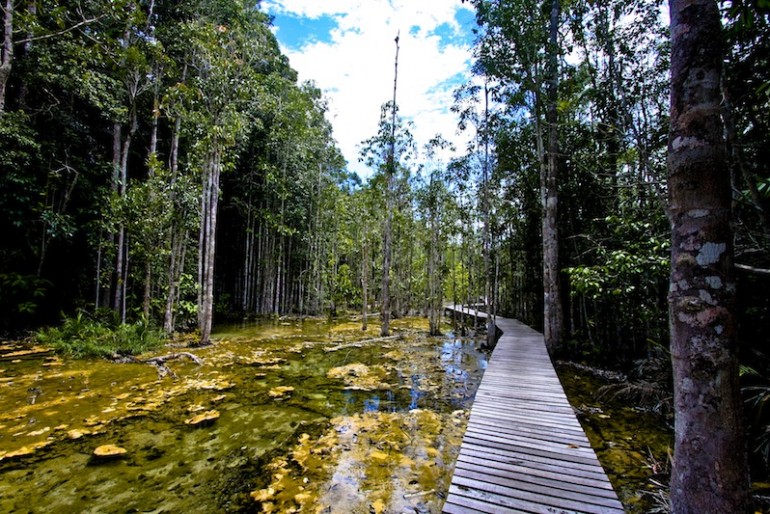Magic Sa Morakot
Exploring Sa Morakot, located in the last significant area of lowland rainforest in Thailand can mean a day of relaxation and enjoyment. I had forecasted a bit of swimming, a nice lunch and some light trekking for this day trip. Sa Morakot is otherwise known as ‘The Crystal Pool’ and is part of the Khao Nor Chu Chi Lowland Forest Nature Reserve. I remember one moment on this trip very vividly, when my friend, a first time visitor to the area, and I stood gazing out across one of the many pools, our cameras slung over our shoulders. We stared into the middle distance, we were silent for a few minutes, and he eventually said, in a sudden contemplative and slightly melancholic tone: ‘It’s so beautiful’. It is moments like this that make me realise just how fortunate I am for living in such a beautifully diverse and dynamic province like Krabi. It’s easy to forget the beauty that surrounds us, only taking notice of Mother Nature’s awesome destructive power, especially in the wake of natural disasters, and ignore the beauty that surrounds us every day of our lives.
Southern Thailand is home to a rich diversity of flora, fauna and ecosystems. The whole kingdom is famed for its beaches, but there is a lot more on offer in Krabi than a few stretches of white sand. Rainforests abound as do coral reef systems, and once you venture out into the vast open countryside there is a wealth of national parks, waterfalls, hot springs, swamps, mangroves and other natural wonders to be discovered.
A unique eco-system
The Khao Nor Chu Chi Lowland Forest Nature Reserve comprises two forest communities that contribute to this unique eco-system: swamp forest and moist evergreen forest. The stream which leads away from the crystal pool also provides the source of what is known as the ‘stream eco-system’ in which birds such as various king-fisher species, fire algae and the water itself all contribute to a very delicately balanced bio-network in which all the organisms rely equally on each other for survival. Twitchers will be interested to know that the swamp is also home to the rare Pitta Gurney, not seen in the wild for almost fifty years until rediscovered here in 1986.
A swamp forest hosts a diversity of plant and tree species that have adapted over thousands of years to tolerate soggy soil conditions. Such species are the Chompuu Nam and the Satieo or Garnua an indicator species of swamp forest having a unique looped root system which enables it to breathe and provides it with stability in wet, low nutrient soil conditions. It also provides food for flying foxes that feast on the outer-flesh of the fruit of the tree, the discarded stones of which are then collected by locals to make a type of oil used in cooking. The carnivorous Nepenthes, another indicator species of poor soil habitat, is another fascinating plant – an insectivorous species whose modified leaves called ‘pitchers’ are filled with fluid that trap and digests insects.
The hike
As we made our way along the 1.4 km long boardwalk which leads to the crystal pool, our guide explained about the various plants while we spotted different species of butterflies and lizards while armies of ants marched across the path and up tree trunks in their never-ending food quest. Sa Morakot is the only pool in which it is possible to swim, and it is a perfect place to do so. At approximately 22m in diameter and 1.5m deep, its clean, ambient waters are comes from the spring upstream flows over a smooth rock-face which makes a great slide or even, if you sit underneath it, a cool neck and shoulder massage.
Eight natural pools dot the area – Nam Lod (Water Passing Through), Cherng Kao (Vallery), Jorakeh Khao (White Crocodile), Nam Tip (Heavenly Waters), Nam Krahm (Indigo Water), Hun Kaeo (Barking Deer), Noy (Small) and Morakot (Emerald), which gives the area its common name. It is possible to reach the source of the crystal pool by following a board-walk that leads there, as well as through one of the trails, although they are poorly marked. Here it is possible to see spring water bubbling up from the ground in a huge deep-blue coloured pool – a truly remarkable sight.
WHEN TO GO AND HOW TO GET THERE
Sa Morakot can be visited at any time of the year and is best during weekdays, when it’s less busy, and in the green season months, when flora and fauna are at their best. To reach Sa Morakot from Krabi, drive about 40 km south to the small market town of Klong Thom on the Krabi–Trang (Phetkasam) Road. Turn left on the road towards Thung Yai and follow the signposts to the Khao Pra Bang Khram No-Hunting Area headquarters, in the village of Baan Bang Tieo, approx 16 km further. Alternatively, it’s possible to take a motorcycle taxi from Klong Thom for around 60 Baht.
If you are driving from Koh Lanta, cover the road from the second ferry out of Lanta to the T-junction of the Krabi–Trang road, turn left and drive to Klong Thom. There, turn right on the road towards Thung Yai and follow the signposts to the Khao Pra Bang Khram No-Hunting Area headquarters, in the village of Baan Bang Tieo, approx 16 km further.
By far the best way to visit is by organized tour. Any agent in Krabi Town or Ao Nang or Koh Lanta or your hotel can book a tour for you, which includes lunch and optional visits to other attractions. An entrance fee of 200 thb (100 thb for kids) applies for Sa Morakot and Khao Phra Bang Khram Nature Reserve.




















